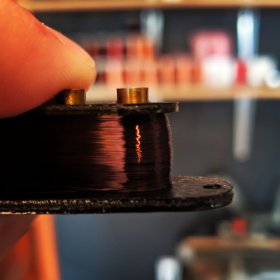Blog
What is Scatter Winding?
What is scatter winding, scatter wound, hand winding and hand wound?
I boast about scatter winding. Many winders do and do so to such an extent that it’s becoming a cliche. And that’s a damn shame because scatter winding actually is something special.
A machine wound pickup is exactly that. A machine spins the pickup bobbin and it also distributes the wire onto the bobbin. The tension of the wire is constant and the distribution is uniform and results in the wire being laid down very evenly (though the uniformity and “evenness” is relative to the machine and the design of the machine), one layer very close to the next, over and over.

A hand wound pickup still uses a machine to turn the bobbin but the wire tension is determined by the fingers and can be manipulated throughout the winding process. And the distribution of the wire is hand guided. Hand winding does not necessarily mean the pickup is scatter wound. A coil can still be wound very uniformly by hand.
“Scatter wound” is kind of a misnomer. It suggests complete randomness and, indeed, is sometimes referred to as “random winding.” But it isn’t random. It’s very intentional and incredibly varied. An experienced winder knows what sort of scatter to use to produce a particular tone, what sort of tension is necessary to scoop certain frequencies or highlight others, and otherwise produce a unique and very beautifully sounding pickup by directing the wire through their fingers.
It is an art unto itself. It’s nearly wizardry. And it’s one of the reasons why hand wound and scatter wound pickups cost more than others. Because they are worth it!
Scatter winding allows for the wire to be laid down unevenly. This puts more air space into a coil and lowers the distributed capacitance that exists between the many turns of wire. And this lowered distributed capacitance allows for more high end to come through while increasing clarity. It also increases the resonant peak and extends the frequency response (which is part and parcel of the clarity and dynamics). The pickup sounds more complex, more open and clear, and louder by the nature of these combined characteristics.
But scatter winding doesn’t always make a better pickup and not all scatter-winding is equal. I always use a cooking analogy. Just because you know the ingredients doesn’t make you a chef or allow you to combine those ingredients and turn them into a delicious tasting food.
Some pickups sound better wound by machine. Even certain pickups that benefit the most from scatter-winding, like a Strat pickup, sometimes benefit from machine winding. Winding such a pickup by machine can lend it a more tight and punchy character as opposed to squishy, quacky and dynamic. It’s one of the big reasons I like to talk to a player before I wind something for them. Maybe they want a really punchy bridge pickups but very vintage sounding and feeling middle and neck pickups.
But in general I find a scatter-wound single coil difficult to beat. It’s why 99.9% of all Revel single coil pickups are hand-wound. The tone is always a little extra special no matter what they are compared with. Try to avoid the idea that hand-winding and scatter-winding is a mindless random laying down of wire with no greater intent than to scatter the wire as much as possible. No doubt some pickups are wound this way. But there would be no way to offer a consistent product if that were the case. And that’s why most big winders use machines. Consistency is a necessity. Like all things pickup winding it’s complicated, which is the nicest possible way of saying that it’s a bottomless pit of minutia.

